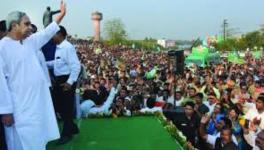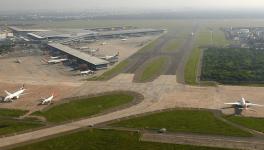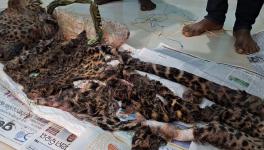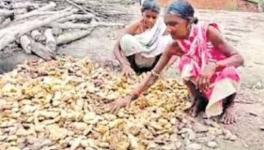Odisha: Poor Catch in Chilika Forcing Fisherfolk to Migrate

The shore of Chilika from Maensa village
Berhampur/Maensa: It was already 10 a.m, 43-year-old Pabitra Dalei, a fish loader was waiting for other fishermen to come for unloading their daily catch. The fish-loaded boat would leave the ghat of Berhampur, an island inside the Chilika lagoon in Odisha’s Puri district, once it meets the daily target of 300 to 600 kg.
“For the past few years, fish supply from villagers of Berhampur and Maensa to Balugaon, the biggest market for Chilika fish, has reduced drastically. Only on high tidal days, the fisherfolk get a better catch, else they have to go deep inside the Chilika lagoon”, Pabitra told this reporter, as he adjusted plastic containers packed with fish and ice.
Earlier, fishing was the most reliable and profitable livelihood of villagers surrounding the Chilika Lagoon, including this island comprising two villages – Berhampur and Maensa. Pabitra’s owner was plying three large boats to Balugaon, full of varieties of fish. Fisherfolk of these two villages were getting a catch that was sufficient to sell as well as meet family needs.
“A decade ago, in three large boats we were carrying nearly 2,000 kg fish to Balugaon every day. Now the supply has reduced between 300 kg and 700kg,” Pabitra said.
Over time, seeing the decline in fish catch in Chilika Lagoon, fisherfolk have started migrating to other states to earn a living. Pabitra’s owner has reduced the boat number and has retrenched many loaders. Only five loaders are working here, including Pabitra.
In this island, male villagers are occupied in catching fish or loading, while women sell sundry fish in the nearby market and keep some for their household consumption. With the decline the catch, no other livelihood option is now left for the fisherfolk except to migrate.
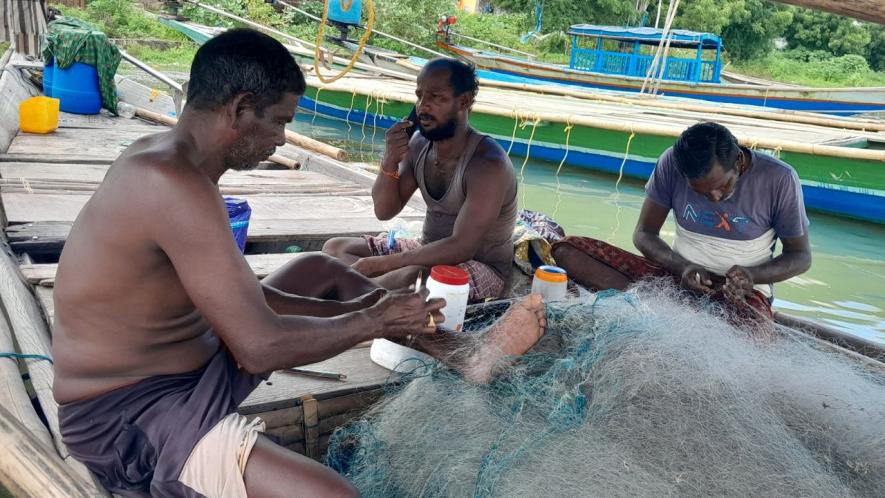
Fisher-folks are knitting nrets before venturing into Chilika
Narendra Samal, 45, was among many who went to Tirupur in Tamil Nadu to work in the printing and embroidery section of a garment factory. But he could not adjust with the hardships and returned to his village after nine years. He now works in a hotel at Satapada, a few km away from his village and a tourist place popular for Irrawaddy dolphins.
“During season, there is a good flow of tourists, while on other days, I go to catch fish, sometimes even spend 12 hours inside Chilika, but bring back hardly anything. If I sell that, I earn about Rs 200”, he said, adding it that was difficult to sustain life only with fishing.
“Today only old and sick people are left behind in this island and are managing their livelihood by catching fish from Chilika, while others have migrated to other states or shifted to other livelihoods”, Narendra said.
New Sea Mouth Blamed
The Berhampur panchayat in Krushnaprasad block, erstwhile name Parikuda comprising five villages – Berhampur, Maensa, Khirisahi, Parala and Bhabanipur -- has nearly 4,500 population, of which 80% are fisher-folk, locally called the keuta community.
The 4,000-year-old Chilika Lagoon is the largest brackish water body of Asia, on the east coast of Odisha, covering 1,100 sq. The lagoon becomes less saline in July-December due to the rush of flood waters from 52 rivers, rivulets and nullahs. It becomes more saline from December-July as the supply of flood water is cut off when the south wind begins to blow and saline water rushes in from Bay of Bengal at the time of high tides.

Chilika lagoon from Berhampur village
In 1981, the Chilika Lagoon was listed as a wetland of international importance in the Ramsar Site, due to its biodiversity. But the lagoon’s ecology is under serious threat due to high anthropogenic pressure, especially after 1980s, as siltation from the inland river systems have been clogging the channels connecting the lake to the sea and the silt does not get flushed out regularly. Decreased interaction with the sea has also reduced salinity, creating another set of problems.
This has led to loss of biodiversity and a decline in productivity, threatening the livelihood of the fisherfolk communities. In 1993, due to this degradation, the lake was listed under the Montreux record as a threatened wetland ecosystem. The mouths of the Chilika Lagoon were almost closed before 2000 to protect its health. The Chilika Development Authority (CDA), a government of Odisha agency, created for the restoration of the Chilika ecosystem, excavated a new mouth 17km down the old one, near Sipakuda village in 2000.
“We urged CDA to clear the siltation by dredging the old sea mouth at Arakhakuda, as it was clogged due to regular siltation. But they did not heed our plight and opened a new sea mouth at Sipakuda, which is only 8 km away from the Berhampur island”, said Ranjan Samal, former member, Purbanchal Matsyajibi Mahasangh, an association opposed the opening of the new sea mouth.
The old sea mouth was 16 km away from Berhampur island, and the sea water was entering through a narrow channel. With opening up of new sea mouth, the main Chilika Lagoon got exposed to the sea directly, leading to an increased rate of salinity. This has destroyed the bio diversity of the lagoon and has affected both production of fish, spawning and fish catch.
“It is the natural phenomenon that due to various factors the lagoon’s mouth shifts from its original place, gets clogged due to siltation and again opens another mouth in a natural way. We wanted to convey this to the officials, but they did not listen,” Ranjan told this reporter.
Opening, Shifting and Closing of mouth
Various factors contribute to the opening, shifting and closing of sea mouths (inlets) time to time. A study conducted by professors Siba Prasad Mishra and Joygopal Jena on “Migration of Tidal Inlets of Chilika Lagoon, Odisha” says, “Offshore Chilika lagoon encounters a number of meteorological events like-eclipses, storms and earthquakes of mild intensity and low vulnerability index. These events sometimes create an inlet. On landfall of storms along the area large volume of water enters the lagoon when the storm weakens the wind blows in a reverse direction which forces the water to create a vent in the low-lying area hence a new inlet is formed.”
Imbalance in ingress and egress of sediment due to their continuous exchange between sea and lagoon causes sedimentation of lagoon, said the study, adding that the varying inflow, littoral drift and such other factors influence sedimentation. This results in shifting the mouths continuously. Some mouths close and some open at various locations in the lagoon in the course of time.
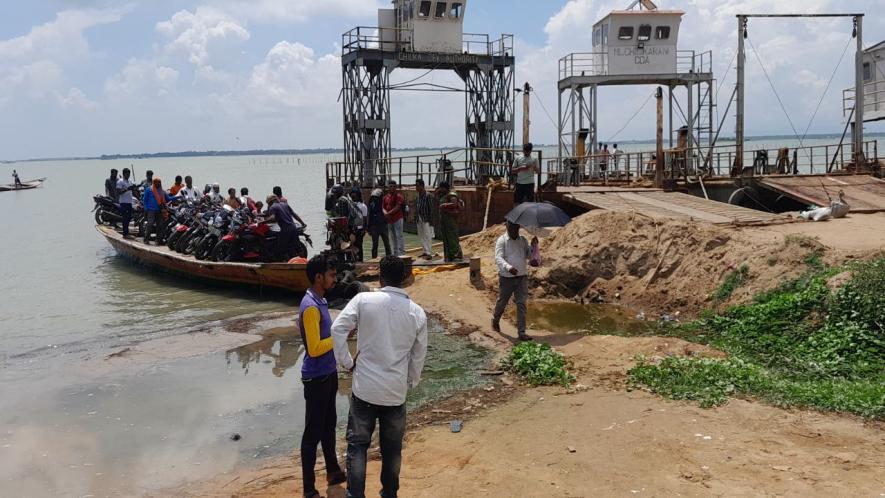
Ferries ply from Satpada to Berhampur, Maensa
Likewise, the closure of a tidal inlet in a lagoon can be seasonal or permanent. A permanent closure of tidal inlet is due to opening of a new mouth or continuous drought for a long period, absence of proper flushing, circulation, dispersion, stratification affects the salinity of the lagoon.
The intense of severe cyclonic storm Fani in 2019 opened four new mouths in the Chilika Lagoon, potentially affecting the hydrological regime of the wetland. While two of the new mouths closed in 2022, two others are still open.
At present, the lagoon is connected to the Bay of Bengal through four tidal inlets at Sipakuda, Mirzapur, Gabakunda and Sanpatna. Of these, only the Sipakuda mouth was artificially dredged east of Magarmunha in 2000. Also, the water dispute between Odisha and Chhattisgarh arising out of building dams upstream of Mahanadi was directly affecting fresh water flow in the lagoon.
The CDA authority concerned said, “The opening of a new sea mouth, opposite the village Sipakuda, has a positive impact on the health of the Chilika lagoon, increasing fish production, along with six new varieties. Earlier, while the total fish production (before the opening of the sea mouth) was 1,700 mt, after the opening of the mouth, it has increased to 12,000 mt.
However, the present situation is related to anthropogenic activities in Chilika by both fisher and non-fisher communities. To catch more fish, they are capturing juveniles by using box nets and zero nets, not leaving them to grow. Besides, non-fishers also make enclosures (gheris) for prawn culture, which also has had a negative impact on the loss of fish catch, the CDA authority said.
A CDA scientific officer told this reporter, “The periphery of the sea mouth area in Chilika Lagoon is the breeding ground for marine lives, but the continuous destructive fishing practices by the fishing community is responsible for the decline in fish catch”.
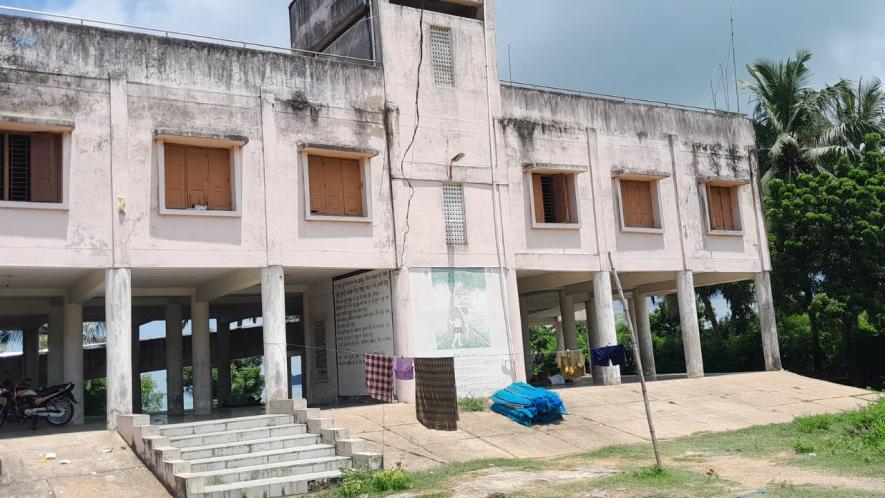
The Cyclone shelter that protects villagers during storm or cyclone
When asked if the increasing number of sea mouths and decrease in the flow of river water from Mahanadi has had any impact on loss in fish catch? He said, “The brackish nature of the lagoon has still been maintained, and our scientists are regularly doing studies on this. But, the illegal capture of juveniles near the Chilika Inlets, to get profit, harms fish catch. We are continuously creating awareness among fisherfolks to use traditional nets and deter them from juvenile poaching. As fisherfolks are now complaining about a loss in fish catch, we will suggest the government ban on fishing during the breeding season”.
Impact of climate change
The Chilika Lagoon sustains 1, 50, 000 fisherfolk living in 132 villages on its shore and islands. Over the years, the eco system of the lake has been under threat due to a host of natural and manmade factors. These factors, such as deformation, siltation, unplanned commercial aquaculture, and natural disasters have led to destruction of natural biotic life resulting in reduction of fish catch. The fisher communities have faced an adverse impact due to reduced fish catch have fallen into debt, poverty, and are being forced to migrate in search of livelihood.
Radheshyam Jena, 52, left fishing in Chilika around seven years ago due to poor fish catch. While his son went to Bengaluru to work in a garment factory, he stayed back. “Fishing was not only our livelihood, it was our way of life. From venturing into the sea, catching different types of fish, prawns and crabs, we were leading a better life”, he said, adding that natural disasters, like the 1999 super cyclone, Phailin in 2013 and Fani in 2019, regular floods besides illegal gheris (enclosure) for prawn cultivation by industries and corporates, seasonal fish restriction and no fishing zones has had a negative impact on traditional fishing communities.
Radheshyam also blamed state government for focusing more on tourism by allowing motor boats in the Chilika Lagoon and a deaf ear toward the issues of the fisher community.
Nanda Kumar Dalei, 80, said, “The motor boats have ruined the environment and polluted the water body. These also create hurdles in the movement of fish, prawns, crabs, dolphins and other creatures”.
From the sea mouth to Magarmukh (the outer channel), is the passage of movement of fish, prawns, crabs and dolphins. As government is now promoting tourism in Satapada, hundreds of visitors use motor boats in this area to catch a glimpse of dolphins. “For a smooth movement of these aqua animals, the government should stop movement of motor boats”, he said.
Prahllad Karan, 56, another fisherman, said, for catching fish traditional fishermen have rights over Chilika Lagoon. “By forming a cooperative society in villages, we have taken some areas on lease for catching fish. Every year, we pay registration fees to continue our lease. But the lease amount is increasing every year, whereas production has declined drastically”.
Also, from the early 1990s, the government started providing lease to non-fisher communities, which is another threat for the traditional fishermen, as they have now encroached most of the areas for prawn cultivation.
Distress migration and debt
Fisherfolk communities are migrating to other states, such as Andhra Pradesh, Tamil Nadu, Karnataka and Goa, to work in garment factories, construction labour, or in seafood processing units, as unskilled labour.
Narendra Jena, 60, also said that after the opening of the artificial sea mouth, plenty of prawn was available for a few years due to increase in salinity, but later it reduced drastically. Those who are reside near the old sea mouth, especially the Keuta communities, are the most affected, he added.
According to Jena, single male migration from the village started 8-10 years ago, but now single female and married couples are also moving out of the village. The main reason for migration is debt, he said.
Most of the fisherfolk have taken loans either to purchase fishing equipment, like boats or nets, or for marriages, health and repairing of houses. “With the meagre income from Chilika, how can a family meet its needs. For two of our daughters’ marriages, we took loan from moneylenders and to repay it at this age, my husband who is 75 years old is also migrating to work as a labourer,” said Saraswati Jena, 68, wife of Bairiranjan Jena, a fisherman.
Dhruba Charan Jena, 70, and his son Pratap Jena, 40, took a loan to repair their dilapidated house. “Me and my son, who was then in his late 20s, went to Bengaluru to work in construction sites, then we worked in garment factories. But when my health started deteriorating due to workload, I returned in 2015. My son returned during Covid”, said Dhruba.
He said the money they earned was sufficient to repay the loan and built an upper floor. He has now opened a small shop in that house and sells all kinds of things (from medicines to needle and thread), while his son drives a Toto rickshaw in Puri.
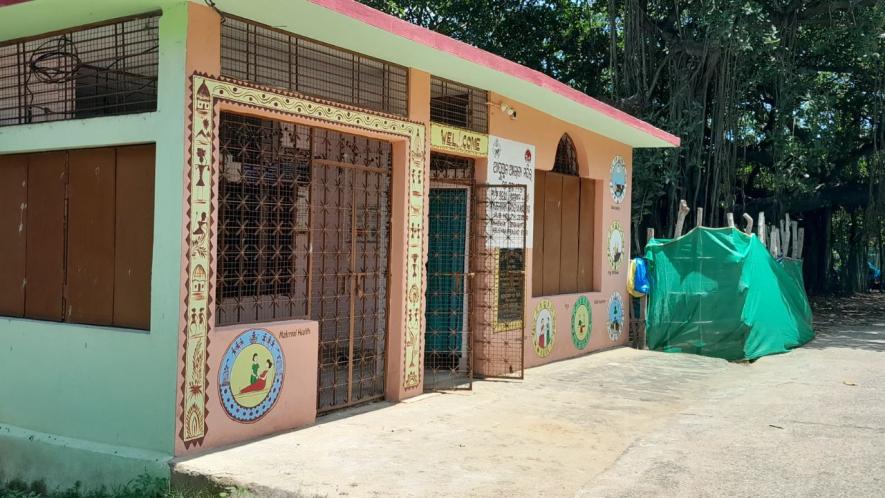
The only sub-sentre in the island for any medical emergency
“Now whatever they are earning is enough to feed the family. I don’t want my son to migrate and stay outside the state. During Covid, I was unable to sleep thinking about my son. Now he has returned and I am relieved”, said Sushama Jena, 63 Pratap’s mother.
A study conducted by MiRC (Migration Information & Resource Centre), a thematic unit of Aide et Action, reveals that many newly-wed couples are migrating to repay loans taken for their wedding. And when they migrate, they become more vulnerable at destination worksites.
During discussions, many such migrants expressed their painful experiences in destination states. The fisherfolk either migrate through middlemen or friends and do not get the wages promised during negotiation. Besides they are forced to work for long hours with low wages. The women, children and elderly left behind, too, face numerous difficulties, including livelihood and socio-cultural challenges.
Alternate livelihood opportunity
Berhampur and Maensa are two villages left as the only islands inside the Chilika Lagoon. The other islands have connected with different panchayats and have surface communication facilities. For any requirement, the villagers of these two villages have to depend on boats that connect them with Puri district.
Boats are the only mode of communication. For delivery or any major health issue, these villagers have to cross the Chilika lagoon by boat to reach the community health centre or district hospital. When this writer visited their village by boat, they shared their plight of travelling on boats, especially during bad weather. Though government has constructed a cyclone shelter, it is not sufficient to protect them from cyclones and floods.
“We do not have a Primary Health Centre inside this panchayat. Recently, a homoeopathy centre and sub-health centre were inaugurated to meet the requirements and only in 2009 we got electricity connection,” said Ranjan, adding there was a demand to build a bridge to connect the village with Brahmagiri, but no one has paid heed to it.
Niranjan Jali’s son Subrat, 26, was working as a supervisor in Kolkata, but the couple couldn’t live without him. “We have only one son. Now he has returned and will start a goat farm,” he said.
Rakesh, 23, after finishing his graduation went to Gujarat to work in a factory, but he couldn’t cope up with paltry wage. He returned and opened a refreshment stall at Satapada along with his friends.
Women have also started finding alternate livelihoods. Anusuya Jena, 32, joined an SHG (Self Help Group) in her village to make incense sticks to support her family financially. “My husband is working in a garment factory in Tirupur. The money he sends is for repaying the loan, so my income is supporting the children’s education and daily needs,” he said.
During the recent elections, Union minister and BJp leader Nitin Gadkari had come to Krushnaprasad and discussed matters with the villagers. He promised to build a bridge connecting Satpada to Berhampur, Maensa and Janhikuda. “Once the bridge is constructed, it will solve most problems of these two villages”, said Santosh Ku Jena, Sarpanch of Berhampur panchayat.
The writer is a freelance journalist based in Bhubaneswar, Odisha.
(All photographs by Rakhi Ghosh)
Get the latest reports & analysis with people's perspective on Protests, movements & deep analytical videos, discussions of the current affairs in your Telegram app. Subscribe to NewsClick's Telegram channel & get Real-Time updates on stories, as they get published on our website.











